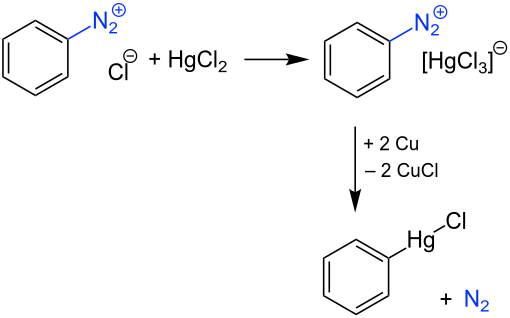Nesmeyanov reaction
The Nesmeyanov reaction , or Nesmeyanov reaction , is a name reaction in organic chemistry. It was first described in 1929 by the Soviet chemist Alexander Nikolaevich Nesmeyanov (1899–1980). This reaction is used for the metalation of aromatic compounds .
Overview reaction
In this reaction, a diazonium salt reacts with a salt with the addition of copper powder to form an organometallic compound with the elimination of nitrogen. This is illustrated here using the example of the reaction of phenyldiazonium chloride with mercury (II) chloride (HgCl 2 ) to form phenyl mercury chloride:
Reaction mechanism
When phenyldiazonium chloride reacts with mercury (II) chloride (HgCl 2 ), trichloromercurate (II) is initially formed. The addition of metallic copper then produces phenylmercuric chloride and nitrogen. The detailed sequence of the splitting of the phenyldiazonium ions is still discussed in the literature.
variants
In addition to copper powder, iron powder can also be used. This reaction can also bind metals such as thallium, lead, tin, arsenic, antimony and bismuth to the phenyl group.
See also
Individual evidence
- ↑ a b c Entry on Nesmeyanov reaction. In: Römpp Online . Georg Thieme Verlag, accessed on April 2, 2020.
- ↑ a b Eberhard wide Maier, Günther Jung: Organic Chemistry: Fundamentals, classes of compounds, reactions, concepts, molecular structure, natural products, synthetic planning, sustainability , Georg Thieme Verlag, Stuttgart, 2012, p 401, ISBN 978-3-13-541507-9 .
- ↑ a b V. S. Kikot, LA Kazitsyna, OA Reutov: On the mechanism of certain reactions proceeding with the participation of diazonium salts . In: Bulletin of the Academy of Sciences of the USSR, Division of chemical science, Vol. 15, No. 6, 1966, pp. 924-930, doi 10.1007 / BF00846041 .
- ↑ a b O. Reutov: Mechanism of reactions between diazo compunds and metals with formation of organometallic compunds . In: Bulletin of the Academy of Sciences of the USSR, Division of chemical science, Vol. 5, No. 8, 1956, pp. 963-970, doi [10.1007.BF01166411].

